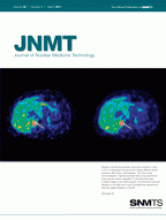
Robert Pagnanelli BSRT(R)(N), CNMT, NCT, FASNC
The NMTCB has continued to make significant progress in the development of the first Nuclear Medicine Advanced Associate examination. After completion of a few minor tasks that remain to be finalized, we will offer the examination as planned on Saturday, June 4, 2011, in San Antonio, Texas, preceding the SNM annual meeting. We are honored to be the sole organization to offer the examination to those qualified in the nuclear medicine field. This achievement is in line with the board's vision of being recognized as the certification organization of choice for nuclear medicine and molecular imaging.
The additional specialty examinations offered by the NMTCB continue to adapt with the field. Candidates will begin to see an increase in material on CT and on solid-state imaging systems, to name a few. The number of technologists with PET credentials has markedly increased during the past year. The number of PET certificate holders is approaching the number of nuclear cardiology technologist (NCT) certificate holders: 612 and 649, respectively. In this time of an employer's job market, technologists with advanced certification have certainly benefited from the immediate qualification of their knowledge that is granted as potential employers see the credential NCT or PET.
Several changes are in process involving the entry-level examination. This examination will begin to see CT topics as well. The current job market has demanded a decrease in nuclear medicine technology training programs and in the number of enrolled students in remaining programs. The entry-level examination has seen a representative drop of 8% in candidates. Nevertheless, as of January 1, 2011, the NMTCB has 23,143 active CNMTs. As in prior years, program graduates have done markedly better on the certification examination than did individuals choosing the pathway of alternate eligibility. The percentage of alternate eligibility candidates who pass the examination is nearly 20 points lower than those graduating from an accredited program. As previously announced, the NMTCB will eliminate the alternate eligibility pathway at the end on 2015, because it is no longer deemed in the best interest of the nuclear medicine field. One further change scheduled for the NMTCB is that candidates will be granted eligibility to sit for the examination only if they graduated from a programmatically accredited school. Graduates of both programmatically and regionally accredited programs are currently eligible to sit for the entry-level examination. Regional accrediting organizations are a network of 6 separate organizations, each responsible for a geographic area of the country. Regional accreditation is a self-regulated, peer review process. Regionally accredited schools undergo a rigorous review that includes various aspects of the education they provide. A regionally accredited school has been proven to meet quality standards set by its accrediting body. Programmatic accredited programs are also held to rigorous quality standards. However, regionally accredited programs do not require students to perform competencies specific to nuclear medicine technology, as programmatic accreditation demands. Furthermore, each school and each affiliated clinical site is visited and assessed during the programmatic accreditation process. Both programmatic and regional accreditation processes are voluntary. In the past, many but not all nuclear medicine technology training programs have participated in both processes. The NMTCB believes that this change in requirements will ensure that all CNMTs have not only a high knowledge base but also high clinical quality standards.
Supplementary information on these topics, as well as other information for CNMTs, can be found on our Web site (www.nmtcb.org).







